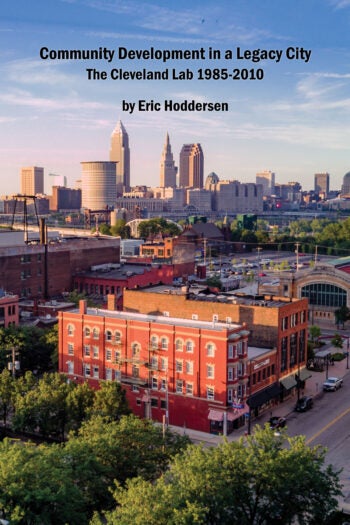Posted on June 14, 2023 at 2:15 PM, updated June 14, 2023 at 2:26 PM Print
 Community Development in a Legacy City Chronicles Cleveland from 1985-2010
Community Development in a Legacy City Chronicles Cleveland from 1985-2010
Eric Hoddersen, a thirty-year Cleveland resident who dedicated much of his career to Cleveland’s community development and strengthening its neighborhoods, has just released a new book that chronicles that expansion within the city.
Community Development in a Legacy City: The Cleveland Lab 1985-2010 offers a unique bird’s eye view of Cleveland’s transition from a legacy city to neighborhood revitalization from the early 1980s and dives into the subprime mortgage foreclosure crisis of 2008 and its immediate aftermath.
“The goal [of this book] is to support a new generation of leaders that are now designing new approaches – from Mayor Bibb and City Council to foundation execs, Cleveland Neighborhood Progress, County Executive Ronayne, and emerging neighborhood leaders,” said Hoddersen.
“They are addressing a new post-pandemic environment with a diminished corporate sector and a city that is among the poorest in the country.”
Having previously served as CEO for Neighborhood Progress, Inc. for 21 years, he moved to Rogue River in Oregon before heading back to Cleveland. It was then that he accepted a position as a senior fellow at the Maxine Goodman Levin College at CSU to write a paper about his community development experience in Cleveland. That led to the book offering a “big picture perspective” of Cleveland.
“There is a one-time federal stimulus infusion that needs to be leveraged for lasting impact,” said Hoddersen. “Hopefully, my account will provide some ideas for how to move forward, but the past practice of the Cleveland Lab is fast disappearing, as is the relevance of my narrative.”
Hoddersen also explains the book is not just a historic account filtered through memory, changing leadership, and evolving civic priorities but also provides a balanced understanding of the community development aspect in Cleveland from 1985-2010 and the challenges and achievements shaped by the larger political and economic landscape of a legacy city.
In the Introduction, he states, “I have chosen to use the term ‘legacy’ rather than the pejorative “rustbelt” since the focus of this account is on assets rather than liabilities, though Cleveland had its share from the Cuyahoga River burning, riots, the city’s municipal default, out-migration of jobs, population loss and the unfavorable national publicity that followed.”
In other words, Hoddersen ultimately hopes his book provides a blueprint and helps contribute to the city moving forward.
“[This book] does provide a benchmark for assessing the agenda going forward,” said Hoddersen. “Santayana – Those who cannot remember the past are likely to repeat the mistakes of the past.”
About the Author
Eric Hoddersen is a 30-year Cleveland resident who dedicated much of his career to Cleveland’s community development and strengthening its neighborhoods. He was formerly a Job Corps Counselor; Teamster Union organizer; Founding Director of Union-Miles Development Corporation; Project Manager of Gordon Square Arcade; Director of the Cleveland Neighborhood Partnership Program, and most notably, CEO and President of the Neighborhood Progress, Inc., Village Capital, and New Village Corporation, where he retired after 21 years in 2010. He was also the Vice Chair of the Ohio CDC Association and the Community Development Partnership Network (national). In addition, he served as a Board member on St. Luke’s Foundation, ShoreBank Cleveland, and the Cleveland School Board Bond Accountability Commission.
He received his BA in anthropology from the University of Washington. He completed graduate studies in political economy at the New School for Social Research and earned a CMN in Non-Profit Management at Case Western Reserve University. His Fellowships include Fannie Mae Fellow at Harvard Kennedy School; Senior Urban Planning Fellow at the German Marshall Fund; MIT School of Urban Planning; and Cleveland State University’s Levin College (now known as Maxine Goodman Levin School of Urban Affairs).
The author lives with his wife, Carolyn, in the Buckeye-Shaker neighborhood.

